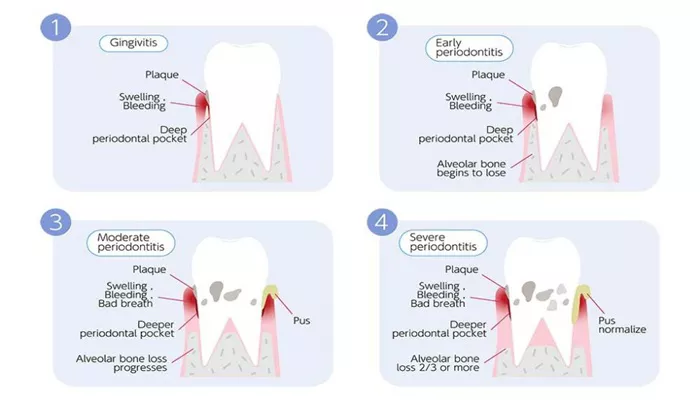Periodontal disease, commonly known as gum disease, is a serious dental condition that can lead to significant oral health issues if not treated promptly. It is characterized by inflammation and infection of the gums and surrounding tissues that support the teeth. This article focuses on the third stage of periodontal disease, known as advanced periodontitis. This stage represents a critical point in the disease’s progression, where the damage becomes irreversible and can lead to tooth loss and other complications.
What Is Third-Stage Periodontal Disease?
Periodontal disease progresses through four stages: gingivitis, early periodontitis, moderate periodontitis, and advanced periodontitis. The third stage, advanced periodontitis, signifies a severe form of gum disease where significant damage has occurred. At this stage, the supporting structures of the teeth, including bone and connective tissue, are severely affected.
Advanced periodontitis is characterized by deep periodontal pockets, significant bone loss, and increased risk of tooth mobility and eventual loss. The condition is often painless in its early stages, making it crucial for individuals to be aware of the symptoms and seek dental care before the disease progresses.
Symptoms of Third-Stage Periodontal Disease
The symptoms of advanced periodontitis can vary among individuals but generally include the following:
Deep Periodontal Pockets: The probing depth between the gums and teeth increases significantly, often measuring between 7 to 12 mm.
This depth allows for more bacteria to thrive, exacerbating the condition.
Bleeding Gums: Gums may bleed easily during brushing or flossing. This bleeding is a sign of inflammation and infection.
Pus Formation: Pockets may fill with pus, which can be seen when the gums are pressed together. This pus is a result of bacterial infection.
Swollen and Red Gums: The gums become noticeably swollen, red, and tender, indicating ongoing inflammation.
Tooth Mobility: As the supporting bone and tissue deteriorate, teeth may become loose or shift position. This mobility can lead to discomfort and difficulty in chewing.
Changes in Bite: The alignment of teeth may change due to the loss of supporting structures, affecting how teeth fit together when biting.
Persistent Bad Breath: Halitosis, or bad breath, is common due to the bacterial infection in the mouth.
Pain and Discomfort: While some individuals may not experience pain, others may feel discomfort, especially when chewing or biting down.
Receding Gums: The gums may begin to recede, exposing more of the tooth root and increasing sensitivity.
SEE ALSO: How to Brush Teeth with Periodontal Disease
The Progression of Periodontal Disease
Understanding how periodontal disease progresses is essential for recognizing the importance of early intervention. The disease typically moves through the following stages:
Gingivitis: The initial stage characterized by inflammation of the gums without bone loss. Symptoms include red, swollen gums that bleed during brushing.
Early Periodontitis: This stage involves deeper pockets (4-6 mm) and begins to affect the bone. Symptoms include increased bleeding and gum recession.
Moderate Periodontitis: At this stage, probing depths reach 6-7 mm, and there is more significant bone loss. Symptoms include persistent bad breath and more pronounced gum recession.
Advanced Periodontitis: The final stage, where probing depths exceed 7 mm, and substantial bone loss occurs. This stage is marked by the symptoms listed above.
Causes And Risk Factors
Several factors contribute to the development and progression of periodontal disease:
Poor Oral Hygiene: Inadequate brushing and flossing allow plaque to accumulate, leading to gum disease.
Smoking and Tobacco Use: Tobacco products can impair blood flow to the gums, reducing healing and increasing the risk of infection.
Genetics: Some individuals may be genetically predisposed to gum disease, making them more susceptible.
Hormonal Changes: Hormonal fluctuations, such as those occurring during pregnancy or menopause, can affect gum health.
Chronic Conditions: Diseases like diabetes and autoimmune disorders can increase the risk of periodontal disease.
Medications: Certain medications that reduce saliva flow can contribute to gum disease by limiting the mouth’s ability to wash away bacteria.
Diagnosis of Advanced Periodontitis
Diagnosing advanced periodontitis typically involves a comprehensive dental examination. This may include:
Clinical Examination: The dentist will assess the gums for inflammation, bleeding, and pocket depth using a periodontal probe.
Radiographic Evaluation: X-rays may be taken to evaluate the extent of bone loss around the teeth.
Medical History Review: Understanding the patient’s medical history, including any chronic conditions or medications, is crucial for an accurate diagnosis.
Treatment Options for Advanced Periodontitis
Treatment for advanced periodontitis aims to manage the infection, reduce inflammation, and prevent further damage.
Options include:
Scaling and Root Planing: This deep cleaning procedure removes plaque and tartar from below the gum line and smooths the tooth roots to promote healing.
Antibiotic Therapy: Local or systemic antibiotics may be prescribed to help control bacterial infection.
Surgical Procedures: In severe cases, surgical interventions such as flap surgery or bone grafting may be necessary to restore lost tissue and bone.
Maintenance Care: Regular dental check-ups and cleanings are essential to monitor the condition and prevent recurrence.
Conclusion
Advanced periodontitis is a serious condition that requires immediate attention. Recognizing the symptoms and understanding the progression of periodontal disease can empower individuals to seek timely dental care. Early intervention is key to managing the disease and preventing irreversible damage to the gums and supporting structures. By maintaining good oral hygiene and attending regular dental visits, individuals can significantly reduce their risk of developing advanced periodontal disease and preserve their oral health for years to come.

